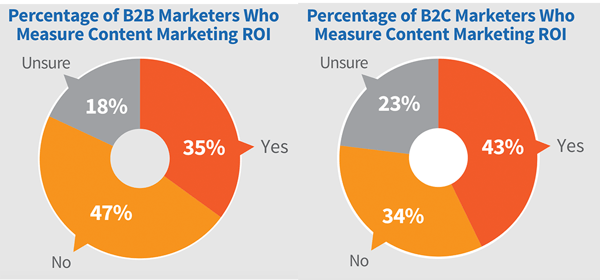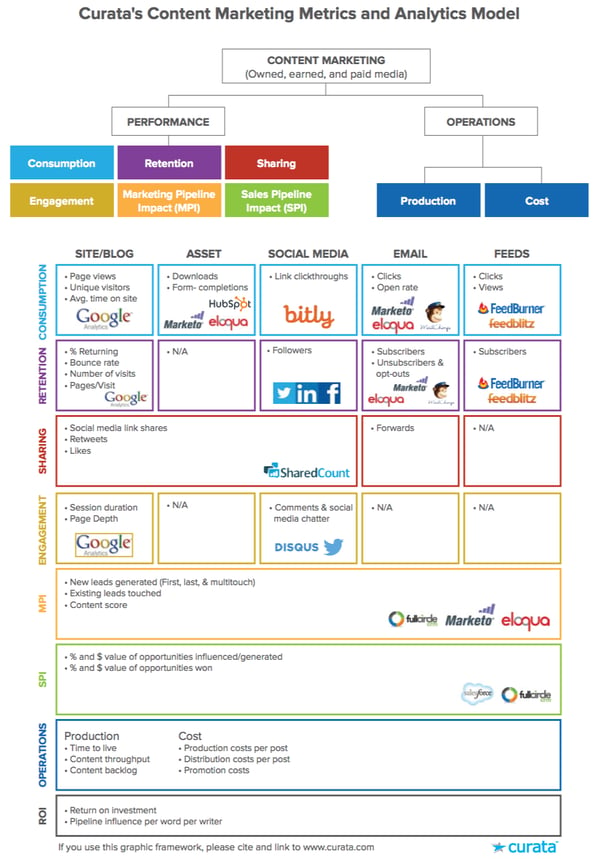Specifically, there are three key reasons — and benefits — for enterprises that use content marketing:
- Increased sales
- Cost savings
- Better customers who have more loyalty
Content marketing is good for your bottom line and your customers - right?
One of the most critical aspects of any marketing campaign is determining the return on your investment (ROI). Is your content strategy actually generating profit? This might sound simple to figure out - but it's not! To calculate the ROI of your content, you're going to need to know a few things.
Content is so much more today than it was five years ago. As Ben Larcey, Co-founder of StoreKit said in the Databox article, A Simple Way to Measure Content Marketing ROI,
“Content marketing is no longer just blog posts and articles, there’s now webinars, podcasts, and video. Each of these formats cost time and money to create. When you can measure each of their ROI, you can then weed out the least profitable ones, and allocate those resources to the most profitable ones. That way, you can further maximize the revenue it generates for you.”
You are likely spending significant dollars on content. Yet without measurement, how do prove, improve, and focus dollars for conversion? Although the vast majority of businesses have committed to providing content, too many do not measure it's ROI.
A study published by the Content Marketing Institute shows that 47% of B2B marketers and 34% of B2C marketers do not measure the ROI of their content marketing strategy.

When asked why they do not measure their content marketing ROI, the majority of B2B and B2C customers say that the process was tedious and time-consuming.
Additionally, 27% of B2B marketers and 26% B2C marketers said that they do not know how to measure their content marketing ROI.
As you start the process towards establishing the measurement of your content marketing, it should begin with you establishing the business outcomes you want. Everything you do in creation and measurement should be guided by what you have set as the outcomes for the brand. After the all the work you go through to create a measurement framework and the specific metrics to provide you data, the last thing you want when evaluating and discussing what you measured is you reaching the conclusion "we may be tracking the wrong data touchpoints."
You need to understand how much it costs for your team to create those blog posts, videos, emails, and whatever else is on your plate. You need to understand if your content is converting your contacts into leads or customers, and how much each of these items is worth. You need to figure out what content and channel are assisting in conversions. You'll also need to be able to set up a system that effectively tracks all of this information. Not so simple after all!
Let's take a look at each of the above factors one by one.
Define the cost of investment
If you have a predetermined content marketing budget, you'll have a relatively easy time calculating the return. For example, if you have a set $3000 monthly budget for content marketing, you already know your total cost. While knowing your total cost is great, this doesn't let you see the whole picture.
Break it down by channel
If you really want to understand how much your content is costing you, it's far more effective to break your costs down by channel. How much are you spending to blog on a monthly basis? To produce emails? Social media? Videos?
To determine how much it costs to produce content within these channels, take the usual metrics into consideration. How much time is your team spending to create and promote the content? How much is your team's time worth? Do you pay for any third-party software, services, or training that help you create the content?
Use the above items and find the average cost of each content marketing channel.
Define the value of the return
Now you know how much it costs to create your content. But before you can figure out if your content is producing a return, you have to know what to track along the way. This is one of the most difficult parts of proving content marketing ROI - what metrics do you track to measure success?
Evaluating conversions and leads
When it comes to your content, what you really want to know is if it's generating conversions. How successful is your content in driving people down the sales funnel and qualifying them as leads?
The Content Marketing Institute tells us that conversions "form the foundation of the content marketing ROI model and offer a basic metric to determine whether a content marketing strategy is successful." Successful content functions (in an ideal world) to convert consumers throughout all stages of the inbound flywheel — from visitor to lead; from lead to a customer; from customer to evangelist; and so forth. How can you tell if your conversions are actually working?
Generally speaking, the gold standard of success in B2B content marketing is the number of Sales Qualified Leads (SQLs) your content generates - unless you're one of the rare B2B companies that sell its products online, in which case you might consider yourself a hybrid B2B/B2C. The challenge is determining how much an SQL is worth to your business (I'll leave that part to you and your team).
B2C companies, on the other hand, usually sell their products and services directly to their customers through online transactions. In these cases, you want to know if your content is leading straight to purchase. It's also easier to determine the value of these interactions - simply track your online sales.
But wait...You now know your content is converting your site visitors into SQLs and customers, and you know the monetary value of each. But how are you supposed to calculate ROI if you don't know where these SQLs and customers are coming from?
Setting up an attribution model
Because conversions are so important in determining the path your customers take to purchase, your next step is setting up an automated system to track these critical metrics. This so-called attribution model allows you to tie a lead or a sale to the piece of content where it all began.
For example, let's say you're an in-house marketer at a cybersecurity software company. How does a lead become sales-qualified at your company? They sign up for a product demo! Through the data your attribution model provides, you can see that the firm's most recent SQL began her journey to your salesperson's demo pitch by stumbling across one of your company's blog posts through a Google search. Because this blog post was her first point of contact with your business, you can lay its cost against the value of the SQL to determine the ROI of the blog post. I can tell you right now that's going to be a big return - massive, in fact, if the demo is successful and the lead becomes a paying customer.
The true challenge lies in figuring out how to set up the attribution model itself. The above instance is an example of a first-touch attribution. This is one of the simplest models you can implement, as it only accounts for one conversion point (the first) and neglects all others that may have come between the first touch and the final purchase. A last-touch model is similar but only tracks the final conversion. A multi-touch attribution model will give you the most accurate depiction of cost, as it tracks each touchpoint along the way - but it's also the most complex to set up.
How we track content ROI
The Digital Outdoorsman uses HubSpot for it's CRM. We use HubSpot to set up attribution models, allowing the platform's prolific automation powers to do most of the heavy lifting.
Because we prefer to track the average costs of content per channel, we find it most effective and time-efficient to implement first- and last-touch models. This gives our clients a very clear idea of what's working (and what isn't) in our content marketing strategy.
Creating a way to measure the ROI of your content is not only doable, but it is also imperative today. Don't be intimidated, it takes some work. Even marketing professionals with years of experience are constantly looking for new ways to measure content marketing ROI. Remember, analytics is the art of being less wrong. The fact is with new channels and the cross-device buying journey, there is going to be gaps in your measurement and you need to acknowledge it. Brands that use new measurement technologies and estimates to find out what really works are much farther along in making better decisions that drive better results. It's a part of an overall digital marketing strategy for your brand.
Besides this article, you may want to check out:
- How to Track Content ROI: A Step-by-Step Guide
- The 10 Best Tools for Measuring Content Marketing
- Measurement and ROI
- Google's Cross-Device Tracking Tool Will Assist in Improving Marketing Measurement
Connor Griffith contributed to this article and segments were repurposed with his permission.



